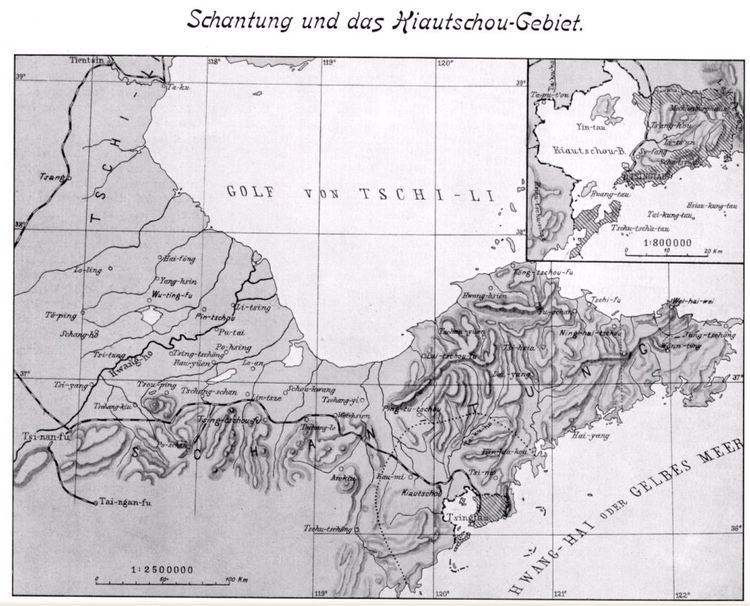Simplified Chinese 胶州湾 Hanyu Pinyin Romanization Koh tseu uae | Traditional Chinese 膠州灣 Wade–Giles Ch'iao-chou Wan Bridges Jiaozhou Bay Bridge | |
 | ||
Postal Kiaochow BayKiautschou Bay (1898–1922) Similar Jiaozhou Bay Bridge, Qingdao Jiaozhou Bay tunnel, Zhan Qiao, Golden Sandy Beach, May Fourth Square | ||
42 km jiaozhou bay bridge and tunnel 08 02 08 32 wmv
The Jiaozhou Bay (Chinese: 胶州湾; German: Kiautschou-Bucht, 36°7′24.44″N 120°14′44.3″E) is a gulf located in Qingdao, China. It was a German colonial concession from 1898 until 1914.
Contents
- 42 km jiaozhou bay bridge and tunnel 08 02 08 32 wmv
- Geography and Ecology
- History
- Connection project
- References
Jiaozhou is the main town of the bay area, which was historically romanized as Kiaochow, Kiauchau or Kiao-Chau in English and Kiautschou in German.
Geography and Ecology
Jiaozhou Bay is a natural inlet of the Yellow Sea (German: Gelbes Meer), with 10 to 15 meters depth to the seabed and deeper, dredged channels to three major ports around the bay: Qingdao, Huangdao, and Hongdao, all of which are ice-free during winter.
It is located on the southern coast of the Shandong Peninsula (German: Schantung-Halbinsel) in East China, and separates Huangdao District from Qingdao City and borders on Jiaozhou City.
The bay is 32 km long and 27 km wide with a surface area of 362 km², approximately two-thirds the area of 100 years ago. According to official data, the surface area has decreased from 560 km² in 1928 to 362 km² by 2003 due to sustained land reclamation activities in recent decades.
The marine species were also decreased by two-thirds during the last 50 years due to urban and industrial development and growth of adjacent areas around the bay. In 1989, only 17 out of 170 species of organisms found in northwestern part of the basin during 1970s. False killer whales occasionally appear in the waters where was once a regular range for the species until in 1980s. On the other hand, Jiaozhou Bay may serve as a suitable location for studying recoveries of coastal marine ecosystems.
History
Jiaozhou Bay was known formerly as Jiao'Ao. The area became widely known to Europeans after a lease was concluded by the German Empire in March 1898 with the Qing government of China.
In 1898 the area was transferred to Germany on a 99-year lease (or until 1997, as the British did in Hong Kong's New Territories), and became known as the Kiautschou Bay concession. The village of Qingdao became the German colony of Tsingtau, and the area became a focus for German commercial development in China, while for the Imperial German Navy it was the naval base for their Far East Squadron.
Because of land speculation in Germany's African colonies, Land Value Tax was introduced as the only tax in the colony. It was a great success, bringing wealth quite rapidly to the colony and also financial stability. The colony was the only government authority ever to exclusively rely on the single tax on land value, and is used as an academic case study to this day about the viability of such a tax system.
With the outbreak of World War I, the Republic of China canceled the Kiautschou lease with the German Empire. This came into force on 23 August 1914, the day of Japan’s declaration of war on Germany, after a Japanese ultimatum for unconditional German evacuation of the colony had expired. The area was occupied subsequently by British and Japanese forces after the Siege of Tsingtao.
China declared war on Germany on 14 August 1917. As an ally of the victors, China expected the formal return of the region at the end of hostilities. However, the Treaty of Versailles acceded to Japanese claims at the Paris Peace Conference and assigned all confiscated German Pacific territories and islands north of the equator to Japan, including Jiaozhou Bay. This arrangement caused China-wide protests known as the "May Fourth Movement", which is regarded as a significant event of modern Chinese history. As a result, the Beiyang government refused to sign the Treaty.
This was known as the "Shandong Problem". It was eventually resolved following mediation by the United States which led to a return to Chinese sovereignty in February 1922.
Connection project
Jiaozhou Bay is situated wholly within Qingdao prefecture. Counterclockwise, the bordering divisions are Shinan District, Shibei District, Sifang District, Licang District, Chengyang District, Jiaozhou City, Jiaonan City and Huangdao District. The entrance to the bay is 6.17 km wide. In 1993, Qingdao City decided to build a traffic corridor for the Jiaozhou Bay region, which includes a tunnel under the inlet and a bridge across Jiaozhou Bay. In December 2006 the construction process started with an estimated completion target of 2011.
